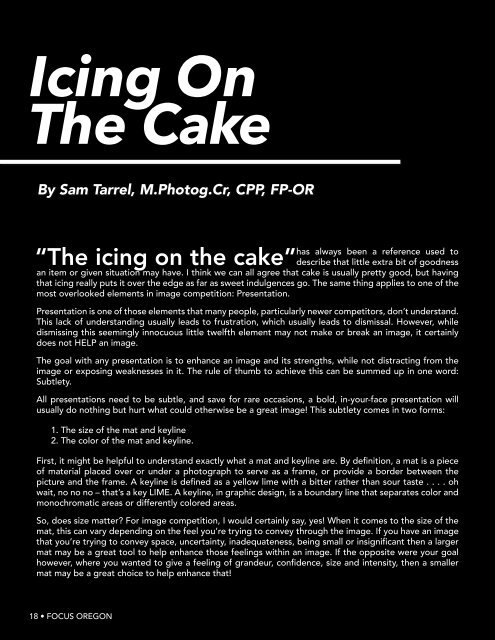V1 Issue 1
Create successful ePaper yourself
Turn your PDF publications into a flip-book with our unique Google optimized e-Paper software.
Icing On<br />
The Cake<br />
By Sam Tarrel, M.Photog.Cr, CPP, FP-OR<br />
has always been a reference used to<br />
“The icing on the cake” describe that little extra bit of goodness<br />
an item or given situation may have. I think we can all agree that cake is usually pretty good, but having<br />
that icing really puts it over the edge as far as sweet indulgences go. The same thing applies to one of the<br />
most overlooked elements in image competition: Presentation.<br />
Presentation is one of those elements that many people, particularly newer competitors, don’t understand.<br />
This lack of understanding usually leads to frustration, which usually leads to dismissal. However, while<br />
dismissing this seemingly innocuous little twelfth element may not make or break an image, it certainly<br />
does not HELP an image.<br />
The goal with any presentation is to enhance an image and its strengths, while not distracting from the<br />
image or exposing weaknesses in it. The rule of thumb to achieve this can be summed up in one word:<br />
Subtlety.<br />
All presentations need to be subtle, and save for rare occasions, a bold, in-your-face presentation will<br />
usually do nothing but hurt what could otherwise be a great image! This subtlety comes in two forms:<br />
1. The size of the mat and keyline<br />
2. The color of the mat and keyline.<br />
First, it might be helpful to understand exactly what a mat and keyline are. By definition, a mat is a piece<br />
of material placed over or under a photograph to serve as a frame, or provide a border between the<br />
picture and the frame. A keyline is defined as a yellow lime with a bitter rather than sour taste . . . . oh<br />
wait, no no no – that’s a key LIME. A keyline, in graphic design, is a boundary line that separates color and<br />
monochromatic areas or differently colored areas.<br />
So, does size matter? For image competition, I would certainly say, yes! When it comes to the size of the<br />
mat, this can vary depending on the feel you’re trying to convey through the image. If you have an image<br />
that you’re trying to convey space, uncertainty, inadequateness, being small or insignificant then a larger<br />
mat may be a great tool to help enhance those feelings within an image. If the opposite were your goal<br />
however, where you wanted to give a feeling of grandeur, confidence, size and intensity, then a smaller<br />
mat may be a great choice to help enhance that!<br />
As a standard though, a mat shouldn’t be too big or too small (insert Goldilocks reference here). The image<br />
below has a very “standard” sized mat, and you will notice that it doesn’t exactly enhance any feature of the<br />
image itself, but simply provides a nice frame for which the image to exist in.<br />
Sam Tarrel<br />
When it comes to color choices of mats and keylines, both<br />
should be colors sampled from within the image, but the mat<br />
in particular should almost act as an extension of the image<br />
itself. This certainly isn’t always the case, but a good mat<br />
color is one that is predominant usually in the background<br />
elements of the image. It’s also important to keep the mat<br />
and keylines “in key” with the image. For most images that<br />
are mid to low-key, this means your mat should be sampled<br />
from a darker area of the image. If the image is a high-key<br />
image, then the opposite would be true, and you would<br />
want to sample from a brighter point in the image for the<br />
mat color.<br />
You’ll also notice how thin the size of the<br />
keyline is. A thin keyline, and in this case,<br />
a double keyline should serve to simply<br />
give finality to the world within which the<br />
image exists. It shows us where the image<br />
starts, and where it stops. If the image<br />
to the left didn’t have a keyline, it would<br />
look as if the subjects were just cut in half<br />
and disappeared from the waist down. By<br />
having the keyline there, it tells the viewer<br />
that there is more to this world that we<br />
just cannot see, and helps keep the eye<br />
in the image where it belongs. However,<br />
if the size of the keyline were much larger,<br />
as pictured in the image below, it begins<br />
to draw our eye to the line itself, and take<br />
us out of the image, which is the opposite<br />
of what a properly done keyline should<br />
do.<br />
Sam Tarrel<br />
When choosing a keyline color, it should be something that isn’t far off<br />
from the mat color. Often times keeping the color the same, and simply<br />
choosing a slightly brighter, or in the case of a high-key image - a darker<br />
color, for the keyline is the best course of action. Notice in the image to<br />
the left, we have a double mat along with a keyline, but the colors that<br />
make up all three are very similar with just a slight variance in tonality.<br />
Sam Tarrel<br />
18 • FOCUS OREGON<br />
SPRING 2018 FOCUS OREGON • 19






